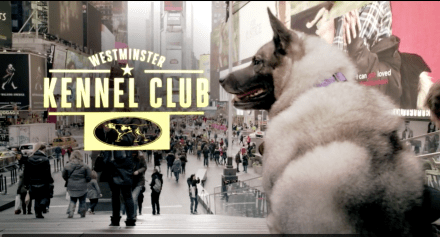“Look, that’s my dog,” Ray said as he pointed to the TV at My Place Restaurant last week. The bartender spun around to see a promo for the 141st Annual Westminster Kennel Club Dog Show which will air on FS1 and Nat Geo WILD on Feb. 13th and 14th. Those seated around the bar saw a few seconds of a Norwegian Elkhound ensconced high above Times Square on the iconic red steps. His smiling face, his purple collar, a stylistic club logo next to his handsome head blipped across the screen. Then he was gone as a multitude of beautiful show dogs strode by at Madison Square Garden.

Linx on the Red Steps high above Times Square
A woman seated next to Ray turned and asked skeptically, “Was that really your dog?” Proudly, Ray produced the proof in a photo of him kneeling next to his 10-year-old buddy Linx the morning of the film shoot.

“Wait ’til you see his solo 30-second promo,” Ray said. This is just the first of several promos he will appear in, which will air on 22 channels across the Fox Sports network from now until the dog show. Did I mention that the Super Bowl airs on Fox Sports?
His 30 seconds of Fame
There were 20 purebred dogs assembled over two days to help promote the oldest, continuously held, dog show in America with a series of TV promos. Each breed was paired with an New York City landmark. A Bulldog on the Brooklyn Bridge, a Portuguese Water Dog in a horse-drawn carriage in Central Park, an Afghan Hound at The Met, and Smooth Collies and a Leonberger on Broadway, among them.
It all began in Times Square one mild morning last December. We drove to Manhattan, parked, and walked Linx into, arguably, the busiest tourist place on earth. It was early when we arrived. Bark, bark, bark, bark all the way down Broadway from 47th Street. Linx was excited to be here! The throngs had not yet filled the urban space. A few looked on as Linx sat for his first picture of the morning with Ray, among empty chairs in the pedestrian walkway, with jumbo-trons, lights, and the New Year’s Eve ball looming in the background.
Then the film crew arrived and we got to work. Put anybody in the city with a film crew and people will think they are a celebrity. Linx took notice immediately and began to strut his stuff for his new found fans. First, a quick trip up and down the red steps. Then across 7th Avenue. A very talented cameraman on roller blades between two taxis in the middle of the wide avenue captured his stroll across the crosswalk. Next up, weaving through bizarre characters down the great white way. Linx sauntered by the statue of liberty, a snowman, a princess, and a fake Rockette hawking tours. Not to miss out on a chance to expand his territory, Linx marked several light posts, garbage cans, and even a fire hydrant in Times Square. Well done for a dog who’s natural instinct is tracking moose in thick Norwegian forests. He had paused for the curious, asking to take his picture and even did a bit with a hot dog cart. Needless to say that was Linx’s favorite take of the day. I never did trust ‘street meat’ but he had no problem scarfing down the dogs.
The Red Steps
At one point we popped Linx up on a marble island with the red steps and the TKTS booth in the background. By now, more curious tourists were watching him get ready for his close up. There were two men standing close by who had spotted the film crew, one with a skateboard. His cohort was trying to get the cameraman to film his friend in action. They were trying to get into Linx’s shot, “Yo, Bro, we are working here,” came the kind request from the cameraman to step out of the frame.

I put Linx in a sit stay. “Can you take his leash off?” came the request. Yes, I had trained my dog in obedience, but remove his leash in Times Square! Luckily, I had packed a long 15-foot leash in my bag, and gladly attached that and snaked it around the back of his body, so it looked like he was just sitting there sans leash, taking in the sights of Times Square, like a dog on a sight-seeing trip. As we wrapped up that take, a man approached us and was thrilled to see a Norwegian Elkhound, not because it was unusual to see a Nordic dog in this urban jungle, but because he had once owned one and had bred a litter. The smile across his face told a story of his nostalgia for his long ago dog. He was then followed by two girls taking his photo to post on social media, where you can now find @TimesSquareDog on Instagram. Now, we were off for one more ascent to the top of the red steps.
While sitting atop the red steps and looking out across the sea of humanity forming below, I could see Linx taking it all in. People sitting nearby, wanting to touch his soft fur, were reaching out to pet him. Sitting next to him, looking at him, with the brilliant display of HD billboards surrounding him, how proud I was of his good-natured temperament after an hour and half of the TV commercial shoot. With Linx’s history with Westminster freshly minted, I thought back nearly 30 years to my first time showing at Westminster. Where Linx’s great, great, great-grandmother Roxanne did us proud. It’s nice to keep it in the family.











